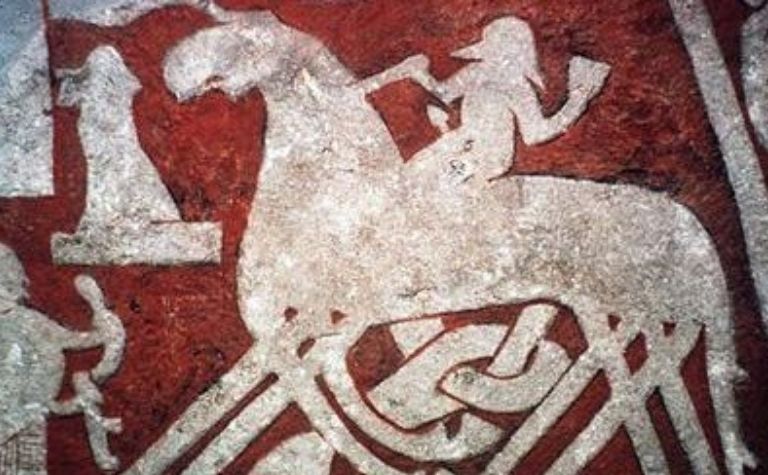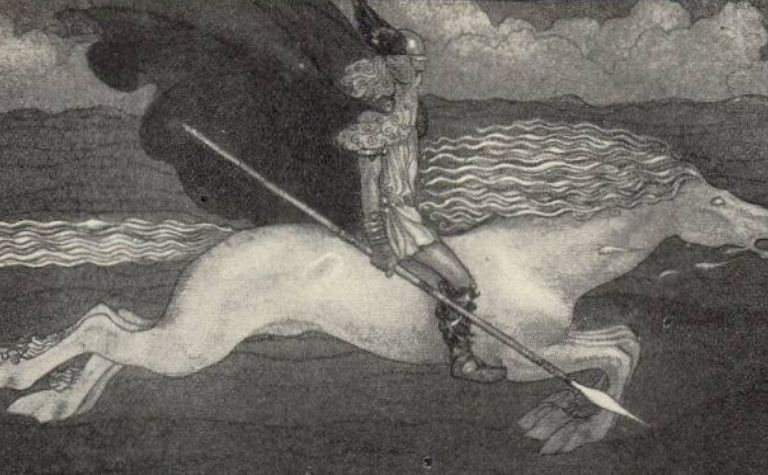A lot of people are fascinated with Loki. Some have known of him for a long time due to his presence in Norse mythology.
Others were introduced to him through the Marvel Cinematic Universe (MCU). However, the MCU doesn’t always accurately reflect the original Norse myths.
One part of Loki’s story that people want to know more about where they hear of it is Loki giving birth to animals.
Loki did give birth to an animal in Norse mythology. He physically gave birth to Sleipnir, Odin’s eight-legged horse, and was also its mother.
Loki also fathered but did not give birth to, two animal children — Fenrir, the wolf, and Jormungandr, a giant snake also known as the Midgard serpent.
Did Loki Have a Serpent Child? Did Loki Have a Wolf Child? How Did Loki Become Pregnant? Are Loki’s children symbols of doom? Keep reading to learn the answers to these questions and others.
Also, see How Old Is Loki? to learn more.

Loki Has Multiple Animals As Offspring
Loki did indeed give birth to an animal in Norse mythology.
Modern-day observers will immediately wonder how this was possible, given that Loki is a male deity.
However, multiple gods have given birth, despite being male. In Greek mythology, Athena emerged from Zeus’s head, already an adult.
Anything is possible when one is speaking about deities and mythology in general. Loki can shapeshift, which opens opportunities for birthing children.
Most Norse myths about Loki focus on his three primary children, Hel, Fenrir, and Jörmungandr.
Hel is a goddess of the dead.
Did Loki Have a Serpent Child?
Loki has a serpent for a son, but the trickster god did not give birth to him.
Jörmungandr is known as the World Serpent, a sea monster so giant that he circles the whole world.
It is also said that when Jörmungandr lets go of his own tail, the world’s end will begin.
Jörmungandr also battles the other gods alongside his father.
Also, see Loki’s Family in Norse Mythology: 5 Facts to Know to learn more.

Did Loki Have a Wolf Child?
Loki has a son named Fenrir, who grew into a massive wolf. The other children of Loki were removed from Asgard, the home of the gods, but Odin stepped in to protect Fenrir.
It is unclear why Odin decided to cast out the other children but keep Fenrir.
All three children were used to foreshadow world-ending events.
However, Odin’s decision allowed Fenrir to grow from a small wolf to a giant, hulking beast. The beast later foreshadows the end of the world and is chained up to prevent it.
It’s said that Fenrir breaking free will be one of the events of Ragnarök, the end of the world.
There is no evidence that Loki gave birth to a wolf.
The ability to shapeshift opens up opportunities for reproduction, but scholars have very little evidence that Loki gave birth to multiple children.
There are few artifacts directly linked to Loki compared to Odin or Thor.
Numerous stories conflict with each other around Loki, adding to the mystery of this chaotic god.
Also, see Is Loki Evil in Norse Mythology? to Know to learn more.
How Did Loki Become Pregnant?
Loki gave birth to one child, Sleipnir.
Loki became pregnant because, as a trickster god, he could change his gender and species with ease.
To bring Sleipnir into the world, Loki changed into a mare and mated with Svaðilfari, a stallion. While in mare form, Loki gives birth to the horse who ultimately belongs to Odin.
Sleipnir is an eight-legged horse and is regarded by the gods of Asgard as the best horse ever.
There are other interesting points about Sleipnir. The eight-legged horse is the favorite of Odin, who can ride Sleipnir through the air.
It is implied through multiple Norse myths that Sleipnir is magical, especially given this ability.
The origin of Sleipnir is complex, as it resulted from Loki trying to get himself out of trouble with the other gods.
According to the Prose Edda, Loki manipulated events to allow a builder to construct a fortress around the home of the gods.
The builder was given an impossible task, but he grew very close to finishing.
The gods demanded Loki do something about it or face certain death. The builder’s payment was steep:
- Sun
- Moon
- The goddess Freyja
Getting the builder to forfeit this payment was absolutely urgent.
Loki responded to the challenge by turning into a mare and drawing the powerful Svaðilfari away from the task of building the walls long enough for the builder to miss the deadline promised.
The plan worked, but while in mare form, Loki became pregnant.
Sleipnir is well described as a gray foal with eight strong legs.
Everything worked out for Sleipnir since Odin relied on the horse to carry him through the skies, and the horse received nothing but praise throughout the home of the gods.
Also, see Does Loki Die in Norse Mythology? to Know to learn more.
The children of Loki as symbols of doom
While Loki didn’t give birth to a serpent or a wolf, the three children of Loki are critical in Norse mythology.
According to the Prose Edda, the three children (Hel, Fenrir, and Jörmungandr) together signal the rise of Ragnarök, the great battle between the old gods.
Fenrir is chained up but will break free and destroy Odin during the battle of Ragnarök.
Jörmungandr plays a role during the great battle as well, battling Thor and killing him but dying in combat.
In addition to his fatal fight with Thor, the seas will become wild as Jörmungandr lets go of his tail.
Not all of the gods will survive the battle of Ragnarök. Thor, Odin, Loki, Fenrir, Jörmungandr, and others perish during the various conflicts of this world-ending event.
It’s unclear if these gods are reborn at another time or remain dead forever.
Not everything about Ragnarök is considered tragic. Indeed, while the seas will rise to cover the earth, it’s described as a time of renewal and peace.
The earth will be repopulated and made better than before. Two humans will survive, and in time, they’ll watch their offspring grow, inhabit, and explore the newest version of the world.
This specific myth overlaps with other creation-destruction myths in different cultures.
Conclusion
Loki is an intriguing character within Norse mythology. The fact that he did give birth to animals only serves to make him more interesting.
